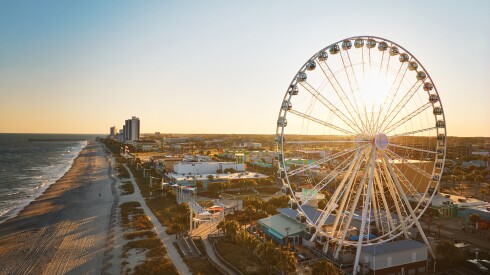Fifteen minutes before noon in Taichung, Taiwan, a long line has formed along a narrow street. Couples lean into each other. Friends scroll absently through their phones. Toddlers wriggle against their mothers’ chests. No one talks much. They’re all in front of the same unmarked gray door, set next to a concrete wall, with Minimal printed in small, black letters beside a square logo. It could be a cocktail bar. A whispery omakase. A members-only lounge.
At exactly noon, the door swings open. The line stirs—shoulders square, phones slip into pockets, and a hush of anticipation settles over the crowd.
These people have come for ice cream. Specifically, from the only ice cream shop in the world with a Michelin star, awarded in 2024. And it’s takeaway only, with service—polite and attentive—that is hushed. The experience is brief by design.
“Ice cream is such a mass commodity. But I want to make flavors that only I can make,” Minimal’s chef and owner Arvin Wan tells me.
Wan’s ice cream bar is purposefully bare bones—a single counter with stainless steel wells holding a rotation of limited-run flavors. He once offered a full tasting menu, where ice, milk, and other ingredients were tweaked and transformed into fantastical textures, shapes, and colors. But in the fall of 2024, he scrapped it all to focus on ice cream.

Minimal earned its Michelin star in 2024; now ice cream enthusiasts line up for a take-away scoop.
Courtesy of Minimal
“I’ve taken everything I learned from the tasting menu and condensed it into a single scoop,” he tells me. To Wan, ice cream is a blank canvas—one that lets him layer flavors and techniques in unexpected ways, like infusing the base with water condensed from steamed cypress.
Each day, there are six flavors. A small cup with two scoops costs US$5. To try all six—spread across four cups—it’s US$37.
Today there’s miso ice cream, its salty richness mellowed by a soy-milk base infused with almonds. A sake sorbet layered with the soft perfume of wild ginger lily flowers. Whiskey rippling through roasted barley. Citrus sorbet jolted awake with Sichuan peppercorns and a touch of pomegranate. Green tea deepened by angelica root sourced from the mountains. Local magnolia flowers infused into vanilla.
But this isn’t ice cream built for spectacle. There are no toppings, no ripples, no clever shards—just scoops, served plain. The colors are muted: soft oranges, beiges, pale creams. Everything is served in a paper cup. Even the gelatos are less dense than the Italian renditions—they’re airy and more restrained. “I prefer a texture that isn’t sticky or cloying,” says Wan. “I want the ice cream to melt into a watery sensation in the mouth. So if certain ingredients have a lot of fiber, pectin, or starch, I specifically remove them.” There is intention in this subdued approach. Each flavor is carefully composed, never overworked. It doesn’t demand attention; it earns it, unfolding slowly, like a secret told in confidence.
The sake sorbet is a nod to the banana ice Popsicles that once lined Taiwanese freezer shelves in the 1950s—creamy, sweet, and banana in name only. The frozen treats used banana oil, a synthetic compound that smells less like fruit and more like memory. Wan recognized something similar in the aroma of sake, that same high, fruity note. So he followed it, using the alcohol to evoke the flavor of those Popsicles.
His green tea ice cream takes a sharper approach. “When tea is cold, the flavors don’t open up the same way they do in hot water,” he says. He doesn’t try to mimic warmth. Instead, he dials up what’s already present—the tea’s bitter, rooty notes—and bumps the saturation with licorice and angelica root. The result is focused, herbal, and slightly electric.
Wan approaches ice cream with rigor—not like a pastry chef chasing decadence, but more like someone tuning an instrument. He thinks in structure, weight, temperature—how each element holds together, how they blend in a singular bite. “I want the richness to come through in the flavor—full and satisfying—but still feel clean and refreshing in the mouth, so you don’t get tired of eating it,” Wan says.
His fixation on cold things started early. As a kid, his family had one of those rare refrigerators that made its own ice—a small, improbable luxury in Taiwan at the time. “I used to eat ice cubes as a snack,” he says, laughing.
He went on to culinary school, then opened Sur, a fine dining restaurant in Taichung where he oversaw the dessert program. Minimal came next, opening in 2021 with a tasting menu format that treated frozen desserts like plated dishes.
“I used to eat shaved ice with nothing on it,” he says.
“Nothing?” I ask.
He pauses. “Maybe a drizzle of condensed milk.”
It tracks. The shop’s sleek, gray countertop. The absence of garnish. The way each scoop feels quietly complete. At Minimal, the name isn’t a concept—it’s a practice.











